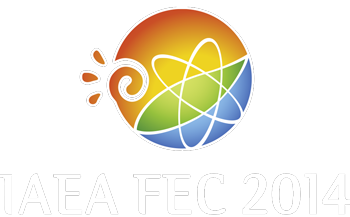Speaker
Dr
Alexander Melnikov
(NRC 'Kurchatov Institute')
Description
Zonal flows and their high-frequency counterpart, the Geodesic Acoustic Modes (GAMs) are considered as a possible mechanism of the plasma turbulence self-regulation. The paper presents the results of the systematic study of GAM properties in the T-10 tokamak with heavy ion beam probe (HIBP) in the core and with multipin Langmuir probes in the edge. It was shown that GAM has radially homogeneous structure of the global eigenmode. The radial distribution of GAM frequency f_GAM is almost uniform, in spite of the temperature dependence on the radius. However, f_GAM grows with the radially averaged electron temperature approximately as T_e^1/2. The GAM amplitude also shows a tendency to be almost constant over the whole observed radial area in the plasma. The typical amplitude of GAM potential oscillations is ~ 20-80 Volts on the background of steady state values of potential up to -1 kV. GAMs are more pronounced during ECRH, when they have the main peak at 22-27 kHz and the higher frequency satellite peak at 25-30 kHz. GAM characteristics and limits of GAM existence were investigated as functions of density, magnetic field, safety factor and ECRH power. It was found that GAMs are suppressed with the density increase. The phase shift between the oscillations of potential and density was about π/2. The poloidal mode number for GAM associated potential perturbation is estimated as m=0 for the whole observed radial interval. The constancy of the GAM frequency with radius is in agreement with recent theoretical findings, which predicts that global GAM (GGAM) can exist in typical tokamak discharges with positive magnetic shear and monotonic temperature profiles. Eigenfrequency of GGAM is constant over the radius in contrast with frequency of GAM continuum.
| Country or International Organisation | Russian Federation |
|---|---|
| Paper Number | EX/P1-45 |
Author
Dr
Alexander Melnikov
(NRC 'Kurchatov Institute')
Co-authors
Mr
Leonid Eliseev
(NRC 'Kurchatov Institute')
Dr
Ludmila Krupnik
(NNC 'Kharkov Institute of Physics and Technology')
Mr
Roman Solomatin
(NRC 'Kurchatov Institute')
Mr
Sergei Grashin
(NRC 'Kurchatov Institute')
Dr
Sergei Lysenko
(NRC 'Kurchatov Institute')
Mr
Stanislav Perfilov
(NRC 'Kurchatov Institute')
Mr
Vitaly Zenin
(NRC 'Kurchatov Institute')

